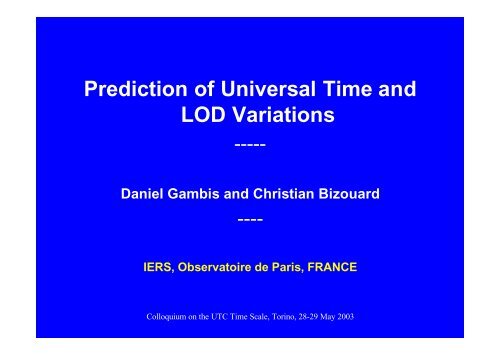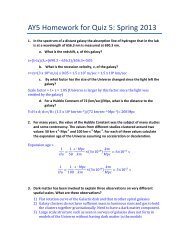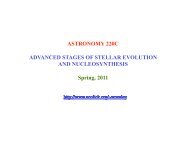Prediction of Universal Time and LOD Variations - UCO/Lick ...
Prediction of Universal Time and LOD Variations - UCO/Lick ...
Prediction of Universal Time and LOD Variations - UCO/Lick ...
You also want an ePaper? Increase the reach of your titles
YUMPU automatically turns print PDFs into web optimized ePapers that Google loves.
<strong>Prediction</strong> <strong>of</strong> <strong>Universal</strong> <strong>Time</strong> <strong>and</strong><br />
<strong>LOD</strong> <strong>Variations</strong><br />
-----<br />
Daniel Gambis <strong>and</strong> Christian Bizouard<br />
----<br />
IERS, Observatoire de Paris, FRANCE<br />
Colloquium on the UTC <strong>Time</strong> Scale, Torino, 28-29 May 2003
Content<br />
1 – Why performing a UT1 prediction ?<br />
2 - Description <strong>of</strong> Earth variations in UT1 <strong>and</strong> <strong>LOD</strong><br />
3 – Current IERS products<br />
4 - Predictability <strong>of</strong> <strong>LOD</strong> <strong>and</strong> UT1<br />
5 - UT1 NTP time scale<br />
Colloquium on the UTC <strong>Time</strong> Scale, Torino, 28-29 May 2003
Why performing UT1 predictions?<br />
• UT1: stellar angle determining the Earth orientation<br />
• No real-time UT1 determination available<br />
• Different applications<br />
– Ephemeris computation<br />
– Celestial navigation<br />
– Astronomical s<strong>of</strong>twares<br />
– Space geodesy orbitography<br />
– Need <strong>of</strong> temporal series <strong>of</strong> DUT1 = UT1-UTC for<br />
automatic procedures<br />
Colloquium on the UTC <strong>Time</strong> Scale, Torino, 28-29 May 2003
Description <strong>of</strong> the variations <strong>of</strong><br />
the Earth Rotation<br />
Colloquium on the UTC <strong>Time</strong> Scale, Torino, 28-29 May 2003
Length <strong>of</strong> day <strong>Variations</strong><br />
Secular drift<br />
Energy dissipation (~ 2.4 ms/century)<br />
Post-glacial rebound (~ -.5 ms/cy)<br />
Decadal fluctuations<br />
Core/mantle torque (amplitude ~ 5 ms)<br />
Global ocean-atmosphere processes<br />
<strong>Variations</strong> from a few hours to about 2 years<br />
Atmospheric causes (zonal winds) (amplitude ~ 1 ms)<br />
Diurnal <strong>and</strong> sub-diurnal variations<br />
Ocean, atmosphere (amplitude ~200 ms)<br />
Colloquium on the UTC <strong>Time</strong> Scale, Torino, 28-29 May 2003
Colloquium on the UTC <strong>Time</strong> Scale, Torino, 28-29 May 2003
Colloquium on the UTC <strong>Time</strong> Scale, Torino, 28-29 May 2003
Colloquium on the UTC <strong>Time</strong> Scale, Torino, 28-29 May 2003
IERS products<br />
Colloquium on the UTC <strong>Time</strong> Scale, Torino, 28-29 May 2003
Current IERS Products<br />
Earth rotation<br />
Polar motion (precision: 100 µas), <strong>Universal</strong> <strong>Time</strong> (precision :<br />
15µs) <strong>and</strong> <strong>LOD</strong> (precision : 20µs)<br />
One-day smoothed solution (1962-now)<br />
One <strong>and</strong> five-day normal point solution<br />
Long-term solution (1/20 year) 1846-now<br />
Bulletins concerning time dissemination<br />
Bulletin C : Announcement <strong>of</strong> the leap seconds in UTC<br />
Bulletin D: Announcement <strong>of</strong> the value <strong>of</strong> DUT1 truncated at<br />
0.1s for transmission with time signals<br />
• The Earth Orientation Center <strong>of</strong> the IERS at Paris Observatory<br />
is in charge <strong>of</strong> the leap second prediction <strong>and</strong> announcement<br />
Colloquium on the UTC <strong>Time</strong> Scale, Torino, 28-29 May 2003
Long term series <strong>of</strong> UT1-UTC <strong>and</strong> <strong>LOD</strong><br />
1891 – 1954: One-lunation series computed from<br />
occultations (Jordi et al solution)<br />
1956 – 1990: astrometric-based series derived in<br />
Hipparcos reference frame (Vondrak<br />
1955 – 1961 <strong>Universal</strong> time scale computed from optical<br />
instruments (Guinot, personal communication)<br />
1962 until now: BIH <strong>and</strong> IERS solutions.<br />
•Only optical observations between 1962 <strong>and</strong> 1972.<br />
•Only LLR <strong>and</strong> Very Long Baseline Interferometry (VLBI)<br />
since 1983<br />
Colloquium on the UTC <strong>Time</strong> Scale, Torino, 28-29 May 2003
<strong>Prediction</strong>s <strong>of</strong> UT1-UTC<br />
Colloquium on the UTC <strong>Time</strong> Scale, Torino, 28-29 May 2003
Current UT1-UTC prediction<br />
procedure<br />
• Modeling includes a bias, a linear trend <strong>and</strong> seasonal<br />
terms, annual <strong>and</strong> semi-annual<br />
• Residuals are modeled <strong>and</strong> predicted as an<br />
autoregressive process<br />
Short term prediction <strong>of</strong> UT1-UTC avaible on a real<br />
time basis<br />
Colloquium on the UTC <strong>Time</strong> Scale, Torino, 28-29 May 2003
Skill <strong>of</strong> the UT1 prediction<br />
statistics over 1963-2003<br />
Horizon<br />
10 days<br />
30 days<br />
90 days<br />
180 days<br />
1 year<br />
2 years<br />
3 years<br />
<strong>Prediction</strong> accuracy<br />
in ms<br />
3<br />
7<br />
21<br />
36<br />
68<br />
163<br />
308<br />
Colloquium on the UTC <strong>Time</strong> Scale, Torino, 28-29 May 2003
Colloquium on the UTC <strong>Time</strong> Scale, Torino, 28-29 May 2003
Long-term predictability variations <strong>of</strong><br />
<strong>LOD</strong> <strong>and</strong> UT1-UTC<br />
Colloquium on the UTC <strong>Time</strong> Scale, Torino, 28-29 May 2003
Colloquium on the UTC <strong>Time</strong> Scale, Torino, 28-29 May 2003
Colloquium on the UTC <strong>Time</strong> Scale, Torino, 28-29 May 2003
Colloquium on the UTC <strong>Time</strong> Scale, Torino, 28-29 May 2003
Colloquium on the UTC <strong>Time</strong> Scale, Torino, 28-29 May 2003
Conclusions<br />
• Possibility to predict UT1 with a 1s accuracy at least over<br />
4 years using a simple method : seasonal, bias <strong>and</strong> drift.<br />
• New prediction methods are under investigation (Singular<br />
Spectrum Analysis, neural network,..)<br />
• Possibility to use Core Angular Momentum prediction for<br />
decadal modeling<br />
• The IERS EOP Center makes now available UT1 on a<br />
real-time basis<br />
Colloquium on the UTC <strong>Time</strong> Scale, Torino, 28-29 May 2003
















